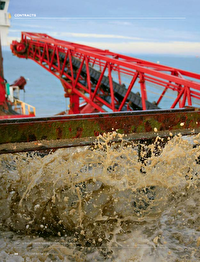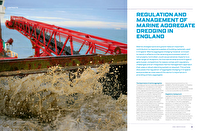Mitigation and management
The marine licence regulates the amount of material that can be extracted from the seabed (along with the minimum thickness cap of the remaining resource), along with the location and timing of dredging activity and the manner (dredging technique) in which extraction can take place.
Potential impacts on sensitive species or habitats are commonly mitigated through conditions on screening restrictions. Such restrictions may range from a complete ban on “screening” (the mechanical process of re-sizing and separating the material during dredging operations) in a particular location to limiting screening to certain times of the year (e.g. so as to avoid key life stages of commercial fish species). Seasonal restrictions may also be conditioned in order to prevent any dredging activity from impacting environmental receptors during sensitive periods.
The MMO will also condition dredging exclusion zones in order to protect areas where the thickness of resource remaining on the seabed approaches the capping layer (required to ensure seabed sediments remain similar at the end of extraction) along with conservation and heritage features. Such zones contain a suitable buffer around the receptor to ensure further impacts from ongoing dredging activity are avoided.
In order to protect features of archaeological interest, prior to commencement of dredging, the MMO must approve project-specific mitigation measures developed with archaeological curators in line with the guidance note “Marine aggregate dredging and the historic environment” developed by BMAPA and English Heritage (BMAPA, English Heritage, 2003). The note provides practical advice on assessing, evaluating, mitigating and monitoring the impact of marine aggregate dredging on archaeological features. The protocol states that all finds of archaeological interest should be reported.
The aggregate dredging can also be managed through the use of active dredge areas, which limit the area of seabed that can be dredged at any one time. This restricts the extent of dredging activity within the licensed area, limiting the potential impacts to the environment and the other uses of the sea. The licence holders’ compliance with both dredging exclusion zones and active dredge areas is monitored and enforced using EMS data.
There are a number of other conditions attached to marine licences to manage potential impacts. For example, to manage the spread of invasive non-native species, conditions in relation to hopper washing restrict the locations and manner in which it can be undertaken. Marine licences generally permit removal of less than 50 m3 of any residual material and hopper washing outside of any exclusion zones. There are also various steps taken in order to manage impacts to other users of the sea. For example, fisheries liaison meetings are periodically held between the MMO, aggregate operators and fishers to facilitate their co-existence. Marine licences also condition compliance with the Fisheries Code of Practice (BMAPA, MMO, The Crown Estate, 2015) covering requirements of timely pre-commencement notification of active dredge areas and dissemination of updates to the fishing industry throughout the dredging operations. This ensures that the licensed activities do not interfere with any fishing activity.
Engagement and transparency
The MMO is fully committed to transparency and maintains a public register in accordance with section 101 of MCAA 2009. The register contains marine licence applications and decisions, along with assessments to support licence applications, supporting evidence and consultation responses. The MMO maintains regular dialogue with the aggregates industry, its representative trade body BMAPA and relevant primary and scientific advisors including Cefas, JNCC, Natural England and Historic England. The MMO also liaises closely with The Crown Estate as the seabed owner.
This extensive engagement enables the MMO to pool the necessary resources and expertise to resolve issues at a strategic level through interaction between the regulators, industry and scientists. The aggregates sector is a mature sector and has benefited from a decade of multidisciplinary research to improve understanding and knowledge of the environmental implications of marine aggregate extraction, funded through the marine Aggregate Levy Sustainability Fund (ALSF) (BMAPA, The Crown Estate, 2013). Strategic oversight of the programme, which ran from April 2002 until March 2011, was delivered through a steering group comprising of the MMO, other government departments, agencies, advisers, the marine aggregate industry and The Crown Estate. Additionally, the outputs from the ALSF helped to inform how the marine aggregate sector is presently managed.
Building on the concepts of the previous ALSF research and strategic cooperation, the Regional Seabed Monitoring Plan (RSMP) approach was developed and jointly funded by the MMO, marine aggregate industry, Defra, Welsh Government and The Crown Estate. This innovative project delivers the seabed monitoring required to fulfil the conditions of marine licences for aggregate extraction on regional basis, covering the main marine aggregate extraction areas. The RSMP surveys have been undertaken since 2014, providing a robust and coordinated way of data gathering, creating opportunities for cost savings for the industry and helping regulators to evaluate the potential cumulative and in-combination effects of existing and proposed future dredging activity. This wider research effort led to compliance requirements shifting focus towards the seabed conditions necessary for the marine environment recovery and monitoring activities moving away from the traditional analysis of benthic communities to greater focus on changes in seabed sediment type over time. This successful, coordinated approach between regulators, advisers, policy leads and industry is often considered an example of best practice by the wider marine community.
The Crown Estate, BMAPA and the aggregates industry are also committed to improving the effective and sustainable management of the seabed through transparency and accountability. In 1999, The Crown Estate and BMAPA issued a statement of intent (the “Area Involved” initiative) committing to reviewing all marine aggregate extraction over a rolling five-year period with a view to minimise the area of seabed dredged. Included within the initiative was a commitment to surrender areas no longer containing useful resources of sand and gravel, and to publish an annual report detailing the extent of dredging within the licensed areas. The latest (23rd) report (BMAPA, The Crown Estate, 2020) shows the ongoing commitment to this voluntary initiative. The 2019 20-year review of the “Area Involved” initiative (BMAPA, The Crown Estate, 2018) shows an overall reduction in both the area of seabed licensed and the area of seabed dredged, helping to minimise the environmental footprint of aggregate dredging activity.
Conclusions
The seas around the UK are becoming busier given the expansion of various activities not least offshore windfarms. Such competition for space comes with regulatory challenges. An integrated marine management approach using marine planning has been developed, together with a risk-based approach to regulation, to manage competing interests, requiring decision makers to use best available evidence and ensure finite resources are managed sustainably.














